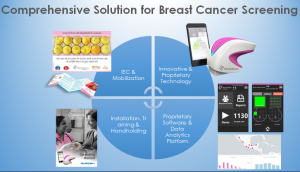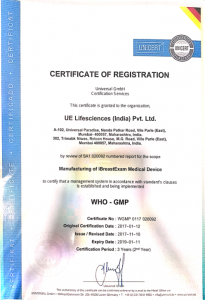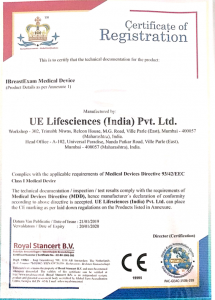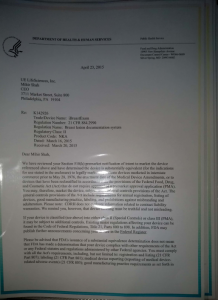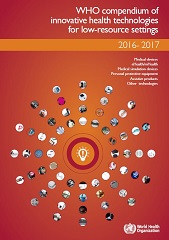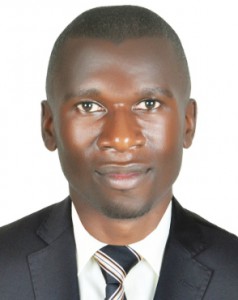“The mothers in Congo care a lot for their babies and young children, that is why they bring the babies into health centers whenever sick, they really really do care for them, and the children get contaminated in health centers... they come out with Ebola!”
Dr. Mike Ryan, WHO Assistant Director General for the Department of Health Emergencies

By Garance F Upham
Vice-President, World Alliance Against Antibiotic Resistance (WAAAR)
Editor in Chief AMR CONTROL
Ex-Member Steering Committee, Patients for Patient Safety, WHO Patient Safety Program (2004-2014)
From Ebola to Antimicrobial Resistance: Coming Into a Health Center Could Kill You!
Is WHO Now Placing Hygiene As a Global Priority? Will Governments Listen?
The views expressed below are those of the Author and do not engage her Board or the WAAAR
The January 2019 World Health Organization (WHO) Executive Board (EB) meeting heard with some amazement that: “More than 85%, even 86%, of Ebola cases in Beni, Democratic Republic of Congo, have been acquired in health systems.” , as Dr. Mike Ryan, WHO Assistant Director General for the Department of Health Emergencies, testified, on Jan 28, in Geneva’s WHO headquarters to the EB, striking like a thunderbolt in clear skies.
He was just back from the Democratic Republic of Congo (DRC), testifying to the by-yearly meeting of the EB attended by the 34 Member States delegations of countries this year (at the level of the minister of health, and/or the director of national health services, and/or director of international cooperation, and approximately the 30 representatives of non-EB members).
And just in case this startling fact escaped the attention of some dozing bureaucrats, Mike went on: “The mothers in Congo care a lot for their babies and young children, that is why they bring the babies into health centers whenever sick, they really really do care for them, and the children get contaminated in health centers… they come out with Ebola!” [1]
He testified as to the progress made in stopping the epidemics in many locations while highlighting that outbreaks still occur in some places.
Clearly, he was telling the world that there would be no Ebola epidemic if healthcare systems were not as filthy as they can be, and therefore were TRANSMITTERS AND AMPLIFYERS OF EBOLA, or of any other hard to treat disease for that matter!
Speaking to people on his way out of the EB room (reserved for state representatives as civil society members-such as myself, in a delegation with Medicus Mundi, as WAAAR is not yet accredited to the WHO-), Dr. Ryan explained how his WHO team were able to stop the epidemic in Beni and most other places of outbreaks by enlisting Congolese people to draft basic prescriptions on hygiene and Infection Prevention and Control (IPC) and enforcing them while training staff.
He added that waste management remains a big hurdle, as children are prone to play in open air hospital refuse, with used syringes and bloody remains!
Dr. Ryan’s statements were indeed all the more remarking that the role of health centers worldwide in the spread of hard to treat, or outright non-treatable and often deadly diseases, is hardly ever talked about except, sometimes, in the specialized literature.
The WHO website on Ebola throughout the massive epidemic that struck West Africa in 2014-2015 never even mentioned “patient to patient transmission” or the role of un-hygienic health centers and notably dirty injections.
Meanwhile, the media was then, and is today, full of articles on Ebola as the result of poor people’s ignorance (sic), refusal to admit disease (sic), or reluctance to bury their dead in our Western ways, resisting to healthcarers sometimes with extreme violence, at times destroying health centers. Such articles are too numerous to be listed here.
Back in November, Dr. Peter Salama, recently made the third Deputy Director General by the DG Dr. Tedros Adhanom Ghebreyesus, started to publicly mention the role of health centers as “transmitters” and “amplifiers” of Ebola, notably to children, but was cautious not to offend the RDC authorities in mentioning private unregulated health centers as transmitters. [2]
Dr. Ryan did not take such precautions and spoke of health care centers overall as guilty of spreading diseases.
Let us quote (1970s early Ebola discoverer) Susan P. Fisher-Hoch writing in 2005 on the history of nosocomial outbreaks of Virus of Hemorrhagic Fevers (VHF) such as Ebola, or Lassa, flaring up in Nigeria today, and other VHF: “Poor people are uneducated, not stupid. Even in the remotest settings, the community grasps very quickly that the hospital is where people become infected with VHFs, so they immediately desert the hospital, and even hide their sick from medical personnel. » [3]
In the light of Fisher-Hoch’s understanding, and considering that the region has been plunged into a horrible civil war, with 4 million women subjected to rape and torture as acts of war over the past decades, the fact that populations could engage in violence against Ebola teams is very regrettable, sometimes atrocious, but hardly surprising. The press, there too, which massively covered the Nobel Prize to Dr. Denis Mukwege [4] , doesn’t place this violence neither in the context of dangerous health structures, nor of the war-like situation in this part of the world. We can only hope that the elections recently held be a harbinger of less violence in the DRC and the region. We can only admire those Congolese people helping to vaccinate, attempting to treat, trying to implement IPC in life threatening situations.
While there has yet to be an evaluation of the Merck Ebola vaccine efficacy, administered in concentric circles of contacts (and possibly soon adding other vaccines – the Russian EB delegation asked Dr. Tedros to do so), the fact is that massive efforts are deployed, and it may be the case that, without the vaccinations, we would already be in the 10 000 cases range as in Western Africa.
Dr Ryan could be the harbinger of a massive change in the WHO leadership on the need for IPC, which could come back to the forefront as a specialized department under the Emergency Health Department.
However, for that Member States would have to understand and fund that initiative.
How can governments talk of Global Health Security while ignoring the fact that filthy under-equipped health structures with staff untrained in basic hygiene procedure would have been spreading common disease, dangerous diseases (Hepatitis C, HIV, Tuberculosis, now Ebola) and the entire array of drug-resistant diseases (AMR infections) or, tomorrow, bioweapons?
Back in 2015, Dr. Brima Kargbo, Chief Medical Officer, Sierra Leone, explained to an overflow room side event at the UN: “Health carers who died of Ebola were not working in specialized Ebola centers, but in regular health care, because in the later there is not the minimum in terms of IPC, such as gloves, in those places.“
The event entitled: “From Ebola to AMR: the Urgency of IPC” (May 2015 World Health Assembly, WHA, United Nations, Geneva) was co-chaired by the Republic of South Africa and the USA, a WAAAR initiative. [5]
From Ebola to AMR Infections, the role of health structures?
Just published in the Lancet Infectious Disease this fall, a thorough study by the European Centers for Disease Control – ECDC revealed that the majority of antimicrobial resistant infections were contracted in healthcare in the EU and associated European countries region in 2015: ECDC estimated that 426 000 patients contracted an AMR infection during care!
“Findings From EARS-Net data collected between Jan 1, 2015, and Dec 31, 2015, we estimated 671 689 … infections with antibiotic-resistant bacteria, of which 63·5% (426 277 of 671 689) were associated with health care. (…)”
“Considering that, in our study, a large proportion of the burden was due to health-care-associated bloodstream, respiratory tract, or surgical site infections, and that more than half of health-care-associated infections are considered preventable, reducing the burden of antibiotic-resistant bacteria in the EU and EEA through enhanced infection prevention and control measures could be an achievable goal.”
Published in the Lancet, this study, signed by the Burden of AMR collaborative group of the ECDC, [6] was among the most discussed of AMR publications in recent years. However, unfortunately, the discussion centered on the exact numbers more than on the amazing fact: Health structures’ weak or non-existent IPC are largely responsible for the global AMR crisis!
We recalled the outburst of Dr. Dominique Monnet, Head, Antimicrobial Resistance & Healthcare-Associated Infections Programme of the ECDC, (among the co-authors of this 2015 new publication). We were in the last meeting of the DRIVE-AB in Brussels (fall of 2017), debating on Market incentives mechanisms and so forth, and from the round table, Dr Dominique Monnet drew the attention on the room to the basics, and took the risk of sticking out: “Without more efforts on infection prevention and control, any new antibiotics will be like pouring oil on the fire!” (quote from memory).
IPC neglected in national AMR plans to implement GAPAMR
The 2015 UN adopted Global Plan of Action on AMR (GAPAMR) placed Infection prevention and control on top of the agenda. But the UN General Assembly of 2016 on AMR largely ignored this with, I counted, 6 countries mentioning IPC out of over 120 in their statement.
In mid 2018, a meeting of all WHO regions representative experts estimated that there was a real dearth of action:
• Improved communication to policy makers who do NOT think that IPC is important is a key next step
• While IPC core components are important for any country, LMICs would benefit from guidance on minimum IPC requirements (which is not always as expensive as we think)
• Cost of not preventing HAIs (Hospital Acquired Infections) is very high
• Need more research and data on the economic case and cost of HAIs, cost-benefit and cost-effectiveness of IPC interventions
• Need to develop the case to demonstrate that IPC can be low-cost.
Yet another 2019 AMR Resolution
We are in 2019 and that same EB which heard the report on Ebola, or passed and drafted the very good resolutions on WASH (acronym for Water-Sanitation-Hygiene) and on Patient safety, also drafted a Resolution on AMR, which should make participants cry over the sacrifice of their lunchbreak meals (spent in side room debating) because it requires WHO and member states to do more monitoring of antibiotic (AB) use but nowhere does it mention that lack of IPC is the DRIVER of AMR epidemics worldwide.
In it, IPC and WASH are only mentioned as obvious ways to reduce the burden of infectious diseases. [7] Where are you Jim?
Jim O’Neill, in his remarkable AMR Review, had a much better understanding of IPC. [8] [9] see Chapter 6, with annex from the London School of Economics.
Yet, internally the WHO draft (not yet published) on Universal Health Coverage (UHC) and AMR, are excellently drawing attention to that fact. But not Member States declarations, because, coming from Ministries of Health, it is difficult to admit to being part of the problem!
A while back, notable author Dr. Timothy Walsh (discoverer of NDM-1 in India) with co-authors involved in AGISAR WHO, such as Dr Peter Collignon, wrote of CONTAGION as the master word to understand. They wrote that AMR infections spread is not correlated with antibiotic consumption but with risks of transmission either from un-hygienic health care centers or from the environment (lack of waste treatment for husbandry, hospital refuse or antibiotic pharmaceutical production units. [10]
And what of FECAL threat?
In the early years of our understanding of hygiene, the term “fecal threat” (Péril Fécal) came up first with the recognition that contamination from human or animal feces of hands, food, water, was the very important channel for the spread of disease. It is surprising how Ebola contamination (and AMR diseases’ transmission) is just about never mentioned.
WAAAR Vice President and IPC French leader Dr. Vincent Jarlier pointed out that even in hospitals contamination with basins is neglected [11]
Meanwhile, our schools and public places toilets are filthy, even in the USA or the EU, and in emerging countries the situation is terrible.
Fecal threat is generally not mentioned in Ebola, notwithstanding the fact that Ebola victims excrete large quantities of virus in diarrhea/and vomiting and the risks of contamination via this route remain high, hence the space suites. The talk of “cuts” on carer’s hands is just ridiculous.
Studies on Ebola transmission show well that, in cases of intra-familial contamination, it is the carers in contact with excreta who get contaminated, from the 70s until today. [12]
Further, the WHO policy of concentric circle vaccinations with Merck’s Ebola rVSV-ZEBOV vaccine (and soon the Russian vaccines as well, if we understand well the 2019 EB discussions) appears to have reduced the number and intensity of the outbreaks.
In the case of AMR infections, the threats are so vast that, while indeed vaccines [13] need to be developed and used rapidly even in husbandry (the success story of salmon vaccinations), the dangers are really diverse and it’s hard to predict where next threat will come from. That means the threat to populations – in the absence of a massive IPC effort, with adequate funding - is much greater than vis à vis Ebola!
In a pre WHA meeting organized with the Geneva Global Health Hub, G2H2, and the WAAAR Alliance, we sought to spur awareness and brainstorming on these issues with about 50 NGOs represented in attendance. A debate round table was organized with two WHO leaders in AMR: Dr Marc Sprenger, head of AMR Secretariat and Awa Aidara Kane, lead of WHO AGISAR, with Dr. Murfin Purdue, head of REACT Africa and of the Ecumenical Pharmaceutical network.
It included our NGO President (and architect of our national 2015 Preservation of AB Plan) Dr Jean Carlet as well as Mrs Mireille Martini, economist from Finance Watch and the Stiglitz Commission.
I chaired and in introduction, I showed a Bamako 2015 video of the major hospital in an extremely disastrous state, a video done by angry health carers in the face of neglect, just 3 years ago. It speaks for itself. [14]
A review of the litterature would be of interest?
A through review of core topics addressed in the literature and top policy discussions or recommendations would probably come down to: 1) the need for new economic models, 2) the necessity for stewardship, better management of antibiotics, 3) the urgency to reduce AB consumption in human health, 4) the recommendation for patients to abstain from pressuring prescribers for antibiotics, from buying AB over the counter, and from failing to go to the end of their prescriptions (yet all studies point to the need to shorten prescriptions, which are more efficient and less wasteful when shorter), 5) the need to stop/curtail use and overuse of AB in agriculture, from meat to fisheries and from wheat to, even, bio fruits and vegetables (use of glyphosate, recently registered as an antibiotic, and use of streptomycin on bio fruit trees…), 6) reducing pollution of heavy metals and biocides,7) establishing waste management of AB production in emerging countries, 8) management of hospitals waste and 9) waste management of husbandry.
Then, perhaps, infection control would appear!
Among the many examples of priority settings on producing new ABs, the Recent Letter to the Senate [15]
The draft recommendations of the Interagency Coordination Group (IACG) are similarly conceived. The not-too-well informed policy maker will come away convinced that a better management of antibiotics and funding R&D for new products is the most important way to face the rise in AMR infections. Of course IPC is mentioned but it comes only second, in such a way as to understand that reducing infections will reduce the need for antibiotics, obviously true. But health structures are not presented as drivers of AMR outbreaks in communities!
The Ad Hoc IACG on Antimicrobial Resistance
The Ad Hoc Interagency Coordination Group on Antimicrobial Resistance, commonly known as IACG, just released its draft recommendations in January 2019 (to be presented to civil society on Feb 25 at the WHO for discussion). In them, access to antimicrobials and their prudent use come in as the first recommendation (A1), and IPC is subsumed under that:
Recommendation A1: The IACG calls on all Member States to ensure equitable and affordable access to existing and new quality-assured antimicrobials and their prudent use by competent, licensed professionals across human, animal and plant health.
This recommendation must be supported by efforts both to reduce the need for antimicrobials and improve access through:
a. Lowering the prevalence of infection through clean water, sanitation and hygiene;
b. Decreasing the likelihood of diseases and their spread through delivery of existing vaccines and strengthening infection prevention and control measures; “[16]
IPC comes back and again in the text, but it is never said that poor levels of hygiene and unsafe injections, unsafe use of sharps, lack of workforce training, lack of investigations of outbreaks, lack of staff and especially lack of well trained staff, all of that does play the key role in AMR infections explosive spread globally. To repeat what Dr. Monnet said: Without strong IPC, new antibiotics will be fuel on the fire.
At present, all partnership initiatives focus on “new fuels” and superbly ignores the situation: degradation in the EU, catastrophic in LMIC. And similarly in agriculture: while calls to reduce AB in meat production is very important, notably for Critical AB, the urgency of not throwing waste into the environment comes in second, while it should be first.
Nowadays, in families in France or the US, all the talk is on the bad cold, the flu like illnesses or the mild to severe gastroenteritis making the rounds of the schools and how the children bring these back into families. CONTAGION is a household word. But in the sheltered areas of policy makers, the word contagion is basically ignored.
Member States Ministers of Health don’t understand the issues well yet, neither does not-for-profit civil society generally (always sharpening the knives on “access” but forgetting transmission), while among the private sector the pharmaceutical manufacturers dominate, while the IPC related industrial groups tend to complain in private rooms.
Hopefully, the WHO may take the lead in putting IPC as one of the core element to achieve real Universal Health Coverage!
India recently adopted a national IPC Plan within which antibiotic stewardship was integrated as a component. While it awaits each national Indian states endorsement and, above all, implementation (and big investments!), the thought was right: stewardship is subsumed under IPC as a necessary complement. Not the reverse!
We must protect patients, and carers alike. We must prevent dangerous viruses such as Ebola, Lassa, Nipah, Hep.C or HIV from being spread via health structures, and we must prevent antibiotic resistant infections from exploding via filthy health structures. Resisting and rolling back AMR threat demands it, and massive investments to that effect. After that we can talk of adding new antibiotics to our medical care armada. The reverse will only exacerbate the problem, as Dr. Monnet understood it, and could well mean a situation out of control.
ADDENDUM
References and subparagraphs
[1] One may still hear him directly in the live webcast, Jan 28th, second morning session, about 48 mn into the proceedings).
[2] Huffington Post: Series of War Zone Attacks Puts DRC Ebola Outbreak On ‘Edge of Crisis’ and also https://www.huffingtonpost.com/entry/ebola-democratic-republic-congo-outbreak-second-largest_us_5bfdf54be4b0d23c21379bd7?guccounter=1
In the DG Tedros new organization of the WHO there are three very important Deputy DG. Dr. Peter Salama is directly on step higher than Dr. Ryan in the WHO hierarchy. The other two DDGs are the remarkable Dr Soumya Swaminathan, in charge of Programs, that is, with the very difficult role of implementing all that which the Member States want but are not ready to pay for, and the big UHC drive, and a lot of monitoring and accountability. Dr Soumya was previously the DG of the Indian Medical Research Institute.
And the English, Mrs. Jane Ellison, Deputy Director General for Corporate Operations.
[3] Susan P: Fisher-Hoch, British Medical Bulletin 2005; 73 and 74:123-137. https://doi.org/10.1093/bmb/ldh054
In her BMJ article she writes: « With the knowledge of the practices and consequences of poor practice in Africa, and now in Asia, we have to conclude that transmission of blood-borne viruses in medical facilities of all kinds is probably common within the endemic area of the haemorrhagic fever viruses. Indeed, hepatitis C virus (HCV) and human immunodeficiency virus (HIV) may be the viruses most commonly spread by this method. The difference with the haemorrhagic fever viruses is that the consequences of haemorrhagic fever viruses are immediately noticeable, whereas with HCV and HIV it takes years, even decades, for the transmission to be appreciated. »
Susan P Fisher Hoch was co-discoverer of Ebola when it first emerged in the mid 70s. Her book “Virus Hunters”, co-authored with husband McCormick is a must to read.
[4] https://www.nobelprize.org/prizes/peace/2018/mukwege/55721-denis-mukwege-nobel-lecture-2/
[5] WAAAR organized event with EB member and AFRO group leader the Republic of South Africa, the DG of Health Services, Mrs Precious Matsoso, head of delegation, and the USA WHA’s delegate representative, Dr Mitchell Wolfe (now at CDC Washington and then Deputy Assistant Secretary for Global Health). Besides WHO DG Dr. Margaret Chan, who gave a short introduction, the main speaker for WHO was Dr. Edward T. Kelley, Director Service Delivery and Safety.
[6] “Findings From EARS-Net data collected between Jan 1, 2015, and Dec 31, 2015, we estimated 671 689 … infections with antibiotic-resistant bacteria, of which 63·5% (426 277 of 671 689) were associated with health care.(…)”
Title of article: “Attributable deaths and disability-adjusted life-years caused by infections with antibiotic-resistant bacteria in the EU and the European Economic Area in 2015: a population-level modelling analysis”
Alessandro Cassini, Liselotte Diaz Högberg, Diamantis Plachouras, Annalisa Quattrocchi, Ana Hoxha, Gunnar Skov Simonsen, Mélanie Colomb-Cotinat, Mirjam E Kretzschmar, Brecht Devleesschauwer, Michele Cecchini, Driss Ait Ouakrim, Tiago Cravo Oliveira, Marc J Struelens, Carl Suetens, Dominique L Monnet, and the Burden of AMR Collaborative Group 5 Nov 2018, The Lancet ID.
https://www.thelancet.com/journals/laninf/article/PIIS1473-3099(18)30605-4/fulltext
A newsy report on the above: https://ecdc.europa.eu/en/news-events/33000-people-die-every-year-due-infections-antibiotic-resistant-bacteria
[7] http://apps.who.int/gb/e/e_eb144.html, see RESOLUTION EB144/R11
[8] AMR Review, https://amr-review.org/Publications.html, see Chapter 6, 22 March 2016 – Infection prevention, control and surveillance: Limiting the development and spread of drug-resistance, with annex from the London School of Economics (Study by LSE Master’s in Public Administration students on the cost and benefit of WASH interventions in Brazil, India, Nigeria and Indonesia main report.)
[9] Interview with Lord Jim O’Neill in AMR Control http://resistancecontrol.info/introduction/is-that-all-very-little-investment-needed-to-save-us-100-trillion-in-amr-costs/http://resistancecontrol.info/introduction/is-that-all-very-little-investment-needed-to-save-us-100-trillion-in-amr-costs/
[10] « Reduction of antibiotic consumption will not be sufficient to control antimicrobial resistance because contagion—the spread of resistant strains and resistance genes—seems to be the dominant contributing factor. Improving sanitation, increasing access to clean water, and ensuring good governance, as well as increasing public health-care expenditure and better regulating the private health sector are all necessary to reduce global antimicrobial resistance »
Title of article: Anthropological and socioeconomic factors contributing to global antimicrobial resistance: a univariate and multivariable analysis
Peter Collignon, John J Beggs, Timothy R Walsh, Sumanth Gandra, Ramanan Laxminarayan. Lancet Planet Health 2018; 2: e398–405 https://www.thelancet.com/journals/lanplh/article/PIIS2542-5196(18)30186-4/fulltext
[11] https://waaar.org/node/100
http://resistancecontrol.info/amr-control-2018-contents/ Page 42 «CONTAINING CROSS-TRANSMISSION OF MULTI-RESISTANT BACTERIA: A PRIORITY FOR CONTROLLING RESISTANCE IN HEALTHCARE CENTRES». Also in the original French, whole book visible at https://view.pagetiger.com/AMR/AMR2018 page 100.
[12] Bulletin of the World Health Organization, 61 (6): 997-1003 (1983) Ebola virus disease in southern Sudan: hospital dissemination and intrafamilial spread. ROY C. BARON,’ JOSEPH B. MCCORMICK,2 & OSMAN A. ZUBEIR
[13] http://resistancecontrol.info/2018-uk-contents/ See page 60, Chatham House
Establishing the importance of human and animal vaccines in preventing antimicrobial resistance
[14] Report on the event : http://amr-times.info/ and (www.g2h2.org),
The Bamako video (in French but easy to understand in watching): a striking video of Gabriel Touré Tertiary Hospital in Bamako, Mali / extravagant level of…filth! https://player.vimeo.com/video/135319492
2013: 110 000 cases of hospitalized patients / Hospital has 450 beds, it is the main tertiary care hospital of the country. Hospital waste are dumped in the courtyard along with human feces, all toilets are clogged up and closed, garbage is not collected except by families of patients… Premature babes sleep on the floor! And health staff is angrily testifying of neglect!
[15] See the « Joint Letter to the Senate-Help and Finance re-economic Incentives for antibiotics, Feb 5, 2019, which can be read on: https://www.pewtrusts.org
[16] https://www.who.int/…/Draft_IACG_recommendations_for_public_discussion_29011…

